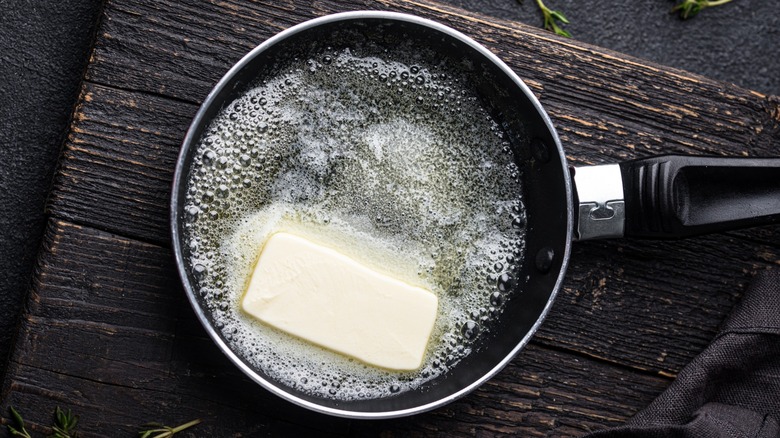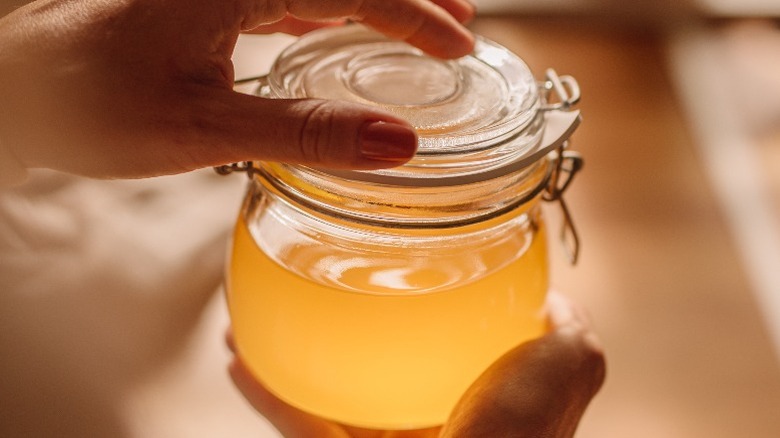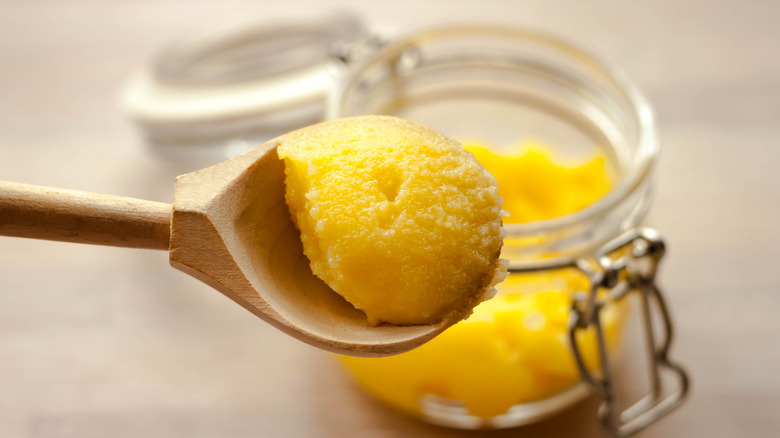No, Ghee And Clarified Butter Are Not The Same Thing
The terms are often used interchangeably, but ghee and clarified butter are not precisely the same. Both are made using similar methods and both contain only butter, but if you were to do a blind taste test, you would immediately know which was which.
Clarified butter, also known as drawn butter, is at once both richer and cleaner in flavor than regular butter. It's that golden liquid we use as a dip for boiled seafood and perfectly buttered movie theater popcorn. But ghee has a nutty flavor somewhere between clarified butter and brown butter. On his website, television chef Alton Brown of "Good Eats" fame calls ghee "an extreme version of clarified butter with a shelf life like uranium." It's a staple used widely in Indian cuisine and an ideal addition to golden milk, aka turmeric latte.
The primary difference between clarified butter and ghee is how you remove the water. When you cook butter, the water first sinks to the bottom, with only a small amount evaporating. Then remove the milk fat that floated to the top, save the butterfat, and leave the water behind, making clarified butter. For ghee, you keep cooking until the water turns to steam and escapes via evaporation.
Clarified butter
Someone once said boiled lobster, lacking its own flavor, is just a vehicle for clarified butter. Though hilarious, it's not so very far from the truth. But it's also useful. Clarified butter has a higher smoke point, meaning it's able to perform in temperatures up to 450 degrees Fahrenheit to regular butter's 350-degree limit, making it perfect for sautéing vegetables or basting a pan-seared steak while lending its unmistakable buttery flavor and aroma.
Because the process of making clarified butter removes the water, notorious for not mixing with fats and oils, clarified butter also stabilizes sauces like hollandaise or béarnaise, helping to maintain a smooth consistency and offering incredible buttery flavor without separating. It's also shelf-stable and lasts up to six months in an airtight container.
To make clarified butter, melt unsalted butter over low heat. The butter will separate into three layers: Milk solids foam up and float on the top and the water (and more milk solids) fall to the bottom, with a layer of golden butterfat in the middle. Simply skim off the floating milk solids with a ladle, slowly pour the golden butterfat layer into a heat-proof container, and discard the rest (the water and the milk solids that sank). You can also strain the fat into your container through several layers of cheesecloth to be sure you're eliminating as much of the milk solids as you can.
Ghee
Ghee lasts much longer than clarified butter because it contains even less water thanks to the longer cooking time. If you buy a jar at the grocery store, you can store it on your shelf unopened for one or two years. But be prepared to spend a small fortune. A pound of name-brand butter costs around $7 on Amazon, but you have to pay over twice that for ghee.
It's much cheaper to make ghee at home. It's the same basic process as making clarified butter — up to a point. But after the layers separate, keep cooking until the butter starts to boil aggressively (it kind of sounds like popcorn popping). That's the water on the bottom turning to steam and pushing through the surface to evaporate. Simultaneously, the milk solids will start to brown, giving off a rich, nutty aroma and sinking to the bottom. To retrieve the ghee, just strain it into a heat-proof container, leaving the browned (not burned) milk solids behind.
Ghee is a core ingredient in Indian cuisine and Ayurvedic medicine, as it is believed to be anti-inflammatory and rich in vitamins and minerals. In addition to Indian recipes, you can use ghee in place of clarified butter to add its roasted, nutty flavor to dishes such as a French omelet or the crispiest, butteriest fried potatoes.


